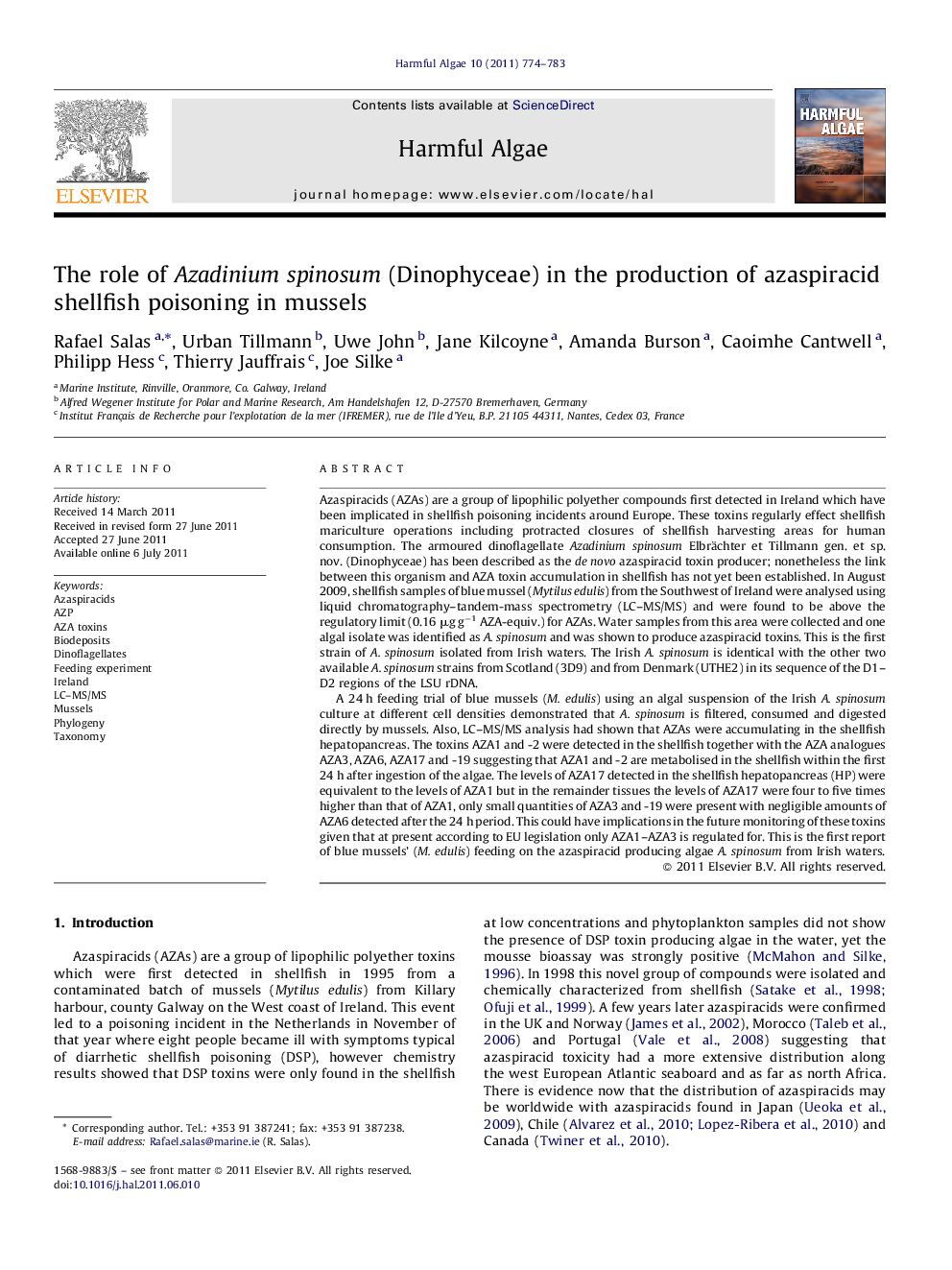| کد مقاله | کد نشریه | سال انتشار | مقاله انگلیسی | نسخه تمام متن |
|---|---|---|---|---|
| 4545696 | 1626960 | 2011 | 10 صفحه PDF | دانلود رایگان |

Azaspiracids (AZAs) are a group of lipophilic polyether compounds first detected in Ireland which have been implicated in shellfish poisoning incidents around Europe. These toxins regularly effect shellfish mariculture operations including protracted closures of shellfish harvesting areas for human consumption. The armoured dinoflagellate Azadinium spinosum Elbrächter et Tillmann gen. et sp. nov. (Dinophyceae) has been described as the de novo azaspiracid toxin producer; nonetheless the link between this organism and AZA toxin accumulation in shellfish has not yet been established. In August 2009, shellfish samples of blue mussel (Mytilus edulis) from the Southwest of Ireland were analysed using liquid chromatography–tandem-mass spectrometry (LC–MS/MS) and were found to be above the regulatory limit (0.16 μg g−1 AZA-equiv.) for AZAs. Water samples from this area were collected and one algal isolate was identified as A. spinosum and was shown to produce azaspiracid toxins. This is the first strain of A. spinosum isolated from Irish waters. The Irish A. spinosum is identical with the other two available A. spinosum strains from Scotland (3D9) and from Denmark (UTHE2) in its sequence of the D1–D2 regions of the LSU rDNA.A 24 h feeding trial of blue mussels (M. edulis) using an algal suspension of the Irish A. spinosum culture at different cell densities demonstrated that A. spinosum is filtered, consumed and digested directly by mussels. Also, LC–MS/MS analysis had shown that AZAs were accumulating in the shellfish hepatopancreas. The toxins AZA1 and -2 were detected in the shellfish together with the AZA analogues AZA3, AZA6, AZA17 and -19 suggesting that AZA1 and -2 are metabolised in the shellfish within the first 24 h after ingestion of the algae. The levels of AZA17 detected in the shellfish hepatopancreas (HP) were equivalent to the levels of AZA1 but in the remainder tissues the levels of AZA17 were four to five times higher than that of AZA1, only small quantities of AZA3 and -19 were present with negligible amounts of AZA6 detected after the 24 h period. This could have implications in the future monitoring of these toxins given that at present according to EU legislation only AZA1–AZA3 is regulated for. This is the first report of blue mussels’ (M. edulis) feeding on the azaspiracid producing algae A. spinosum from Irish waters.
• Confirmation of Azadinium spinosum from Ireland as the producer of azaspiracid toxins.
• A 24 h feeding experiment confirms that mussels (Mytilus edulis) are able to ingest A. spinosum cells directly without the need of vector species.
• AZA toxins can accumulate in mussels above the regulatory level within 24 h.
• There is a rapid conversion of AZA-1 to AZA-17 and AZA-2 to AZA-19 in the mussels’ tissue within 24 h.
• The ratio of AZA-17 to AZA-1 is 5:1 in the mussels’ remainder tissue.
Journal: Harmful Algae - Volume 10, Issue 6, September 2011, Pages 774–783